Masterpiece Story: Monet’s Garden at Giverny
Claude Monet loved gardening almost as much as he loved painting. When he finally settled in Giverny, he created a natural masterpiece which acted as...
Catriona Miller 23 November 2025
10 August 2025 min Read
Jean-François de Troy’s The Declaration of Love is a masterpiece of Rococo genre art featuring a universal moment of anguish and affection.
Jean-François de Troy (1679–1752) was one of the leading painters in France during the reign of King Louis XV (r. 1715–1774). His career spanned a wide range of subjects, such as historical, religious, and mythological scenes. However, it was his tableaux du monde (paintings of fashion) that quickly became his most celebrated theme. They were wildly popular with 18th-century collectors as they captured the elegance, refinement, and intellectualism of the Age of Enlightenment. De Troy’s tableaux du monde were not just fashion plates. They were expertly crafted genre scenes that represented the spirit of the Rococo era. De Troy’s The Declaration of Love is one such work and is easily considered one of his greatest masterpieces.

Jean-François de Troy, The Declaration of Love, 1731, Sanssouci, Prussian Palaces and Gardens Foundation Berlin-Brandenburg, Potsdam, Germany. Detail.
The Declaration of Love is an oil on canvas measuring 91 cm (35 13/16 in.) wide and 71 cm (27 15/16 in.) high. It is a genre scene, which means that it does not allude to a historical, mythological, or religious story. It is simply a presentation of an 18th-century contemporary moment that is left open to interpretation by the viewer. Genre scenes can be among the most interesting subjects to explore because of their flexibility and subjectivity. The Declaration of Love presents a beautiful collection of people relaxing on the grounds of a formal French garden reminiscent of the Château de Versailles.
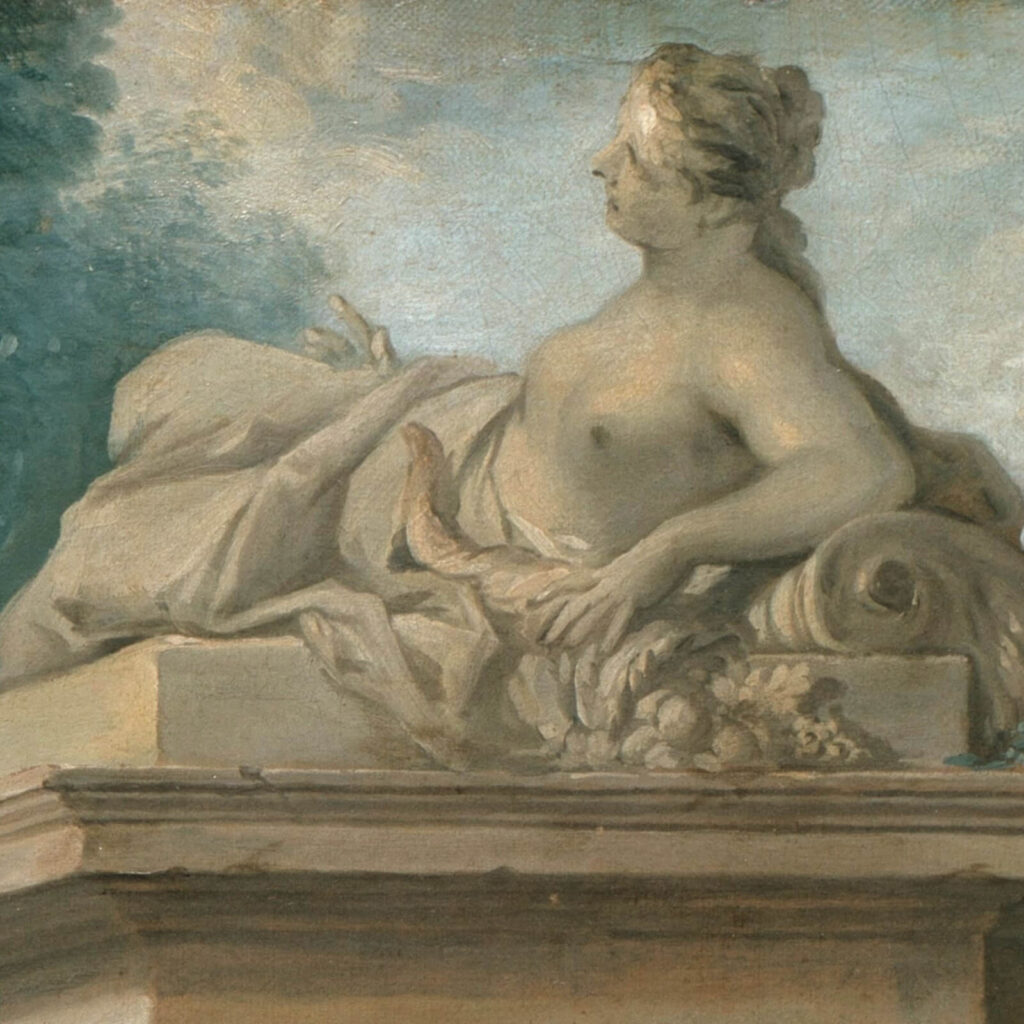
Jean-François de Troy, The Declaration of Love, 1731, Sanssouci, Potsdam, Germany. Detail.
In the foreground, three dashing gentlemen are conversing and interacting with four elegant ladies.

Jean-François de Troy, The Declaration of Love, 1731, Sanssouci, Potsdam, Germany. Detail.
In the background, a refined couple is gracefully descending a flight of stairs. The overall impression is of studied aristocratic relaxation.
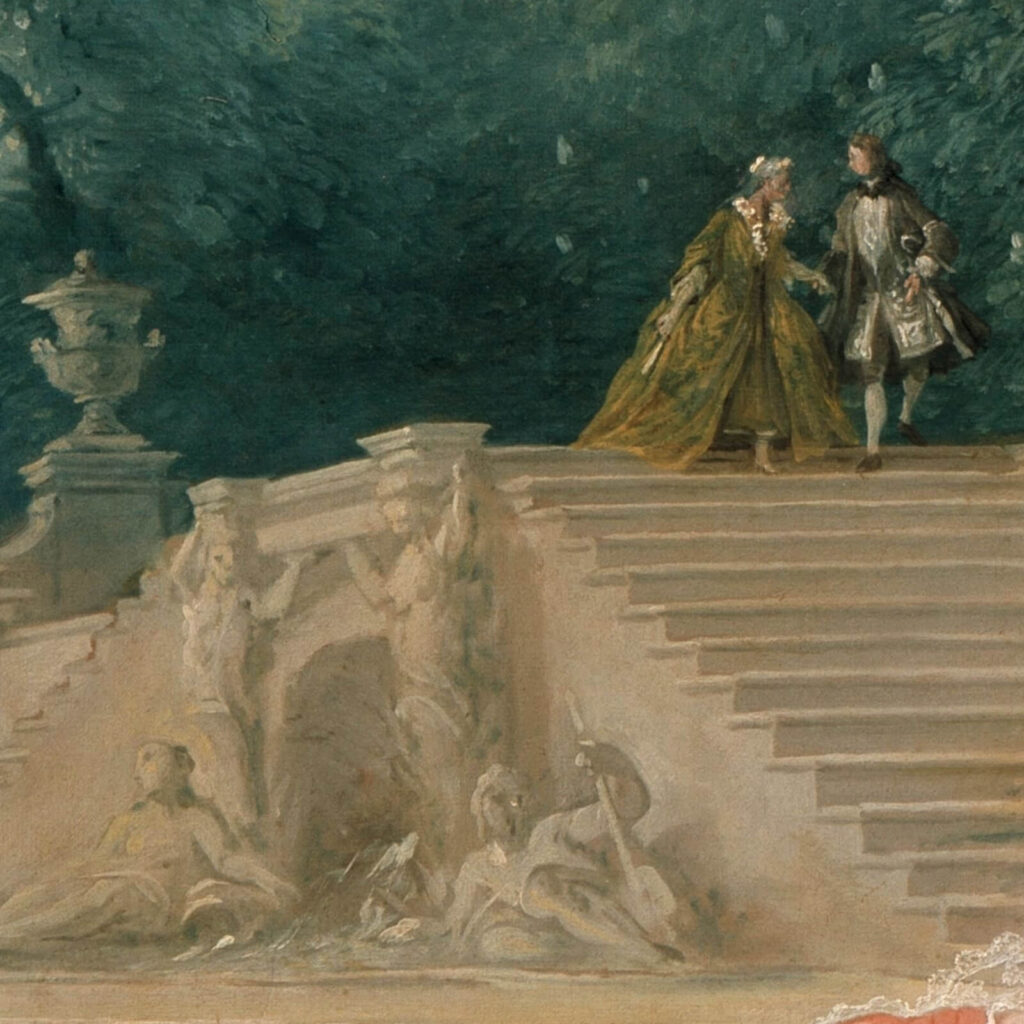
Jean-François de Troy, The Declaration of Love, 1731, Sanssouci, Potsdam, Germany. Detail.
The painting is a tour de force on the verisimilitude of details. De Troy was an expert of capturing the slight nuances of different fabrics, embroideries, and textures. He knew that a peach-colored silk shimmers differently in the sunlight compared to a plum-color velvet.
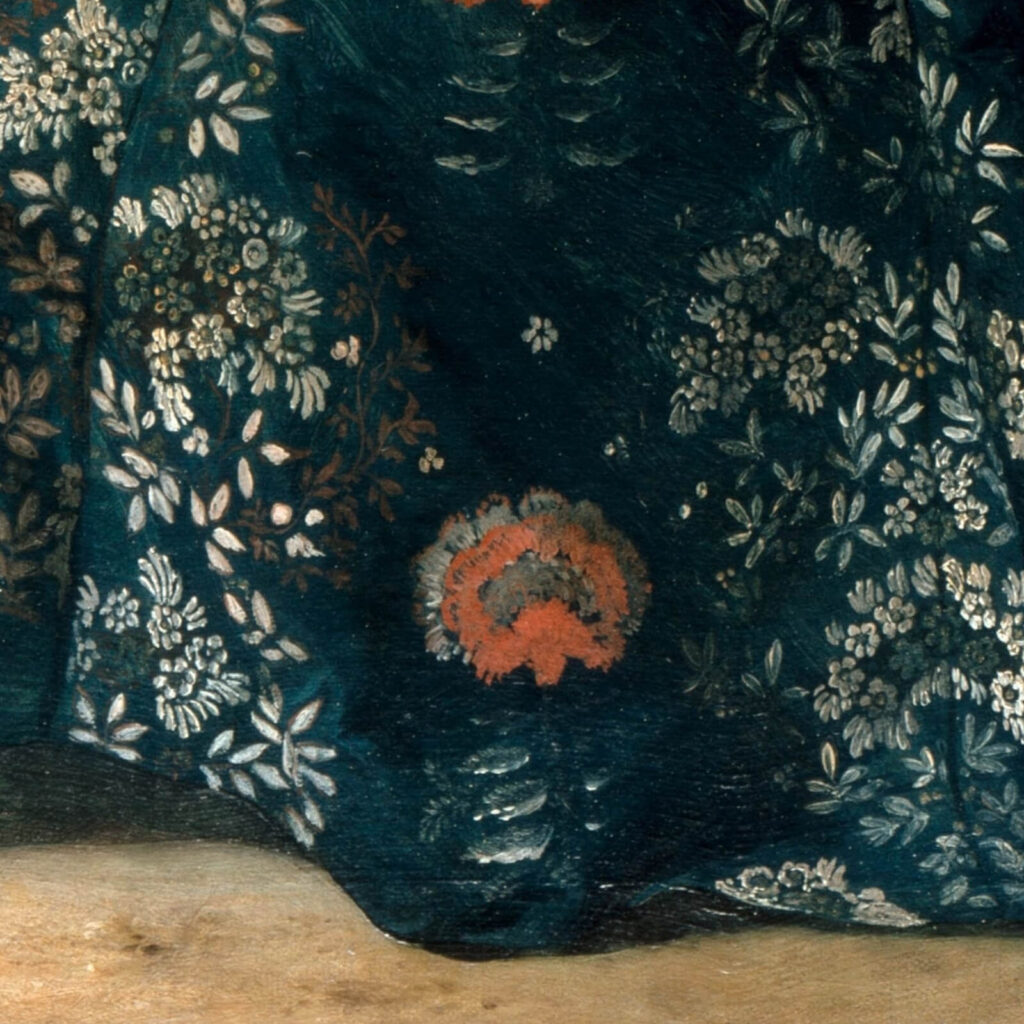
Jean-François de Troy, The Declaration of Love, 1731, Sanssouci, Potsdam, Germany. Detail.
A gentleman’s gray coat creates a different range of shadows compared to a lady’s champagne dress. The laces of sleeve cuffs and head pieces have their own delicate texture compared to the stability of solid ribbons.
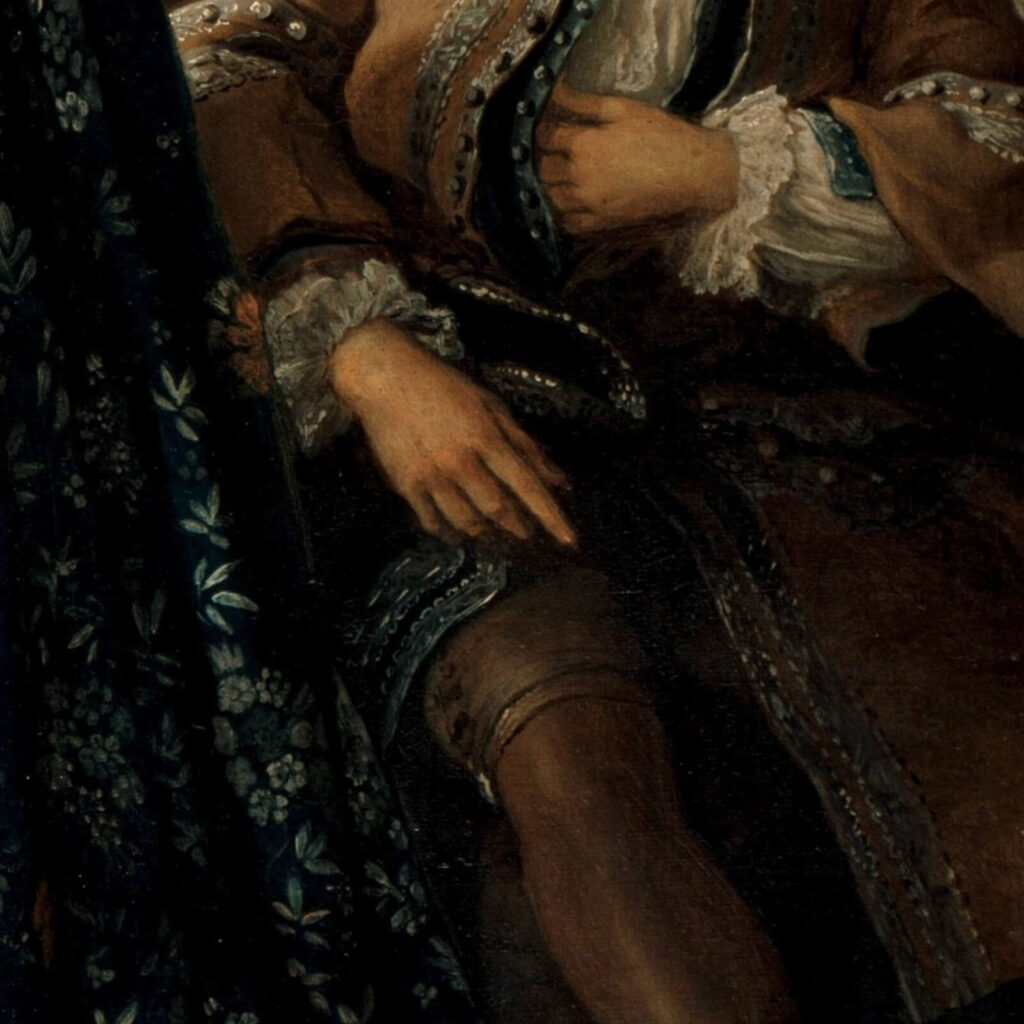
Jean-François de Troy, The Declaration of Love, 1731, Sanssouci, Potsdam, Germany. Detail.
The combination of these different light effects creates an almost photographic realism that transports us, like a traveling time machine, to this 18th-century scene. The viewer can almost imagine one of these elegant people stepping off the canvas to recite Molière or to recount the latest piece of court gossip.
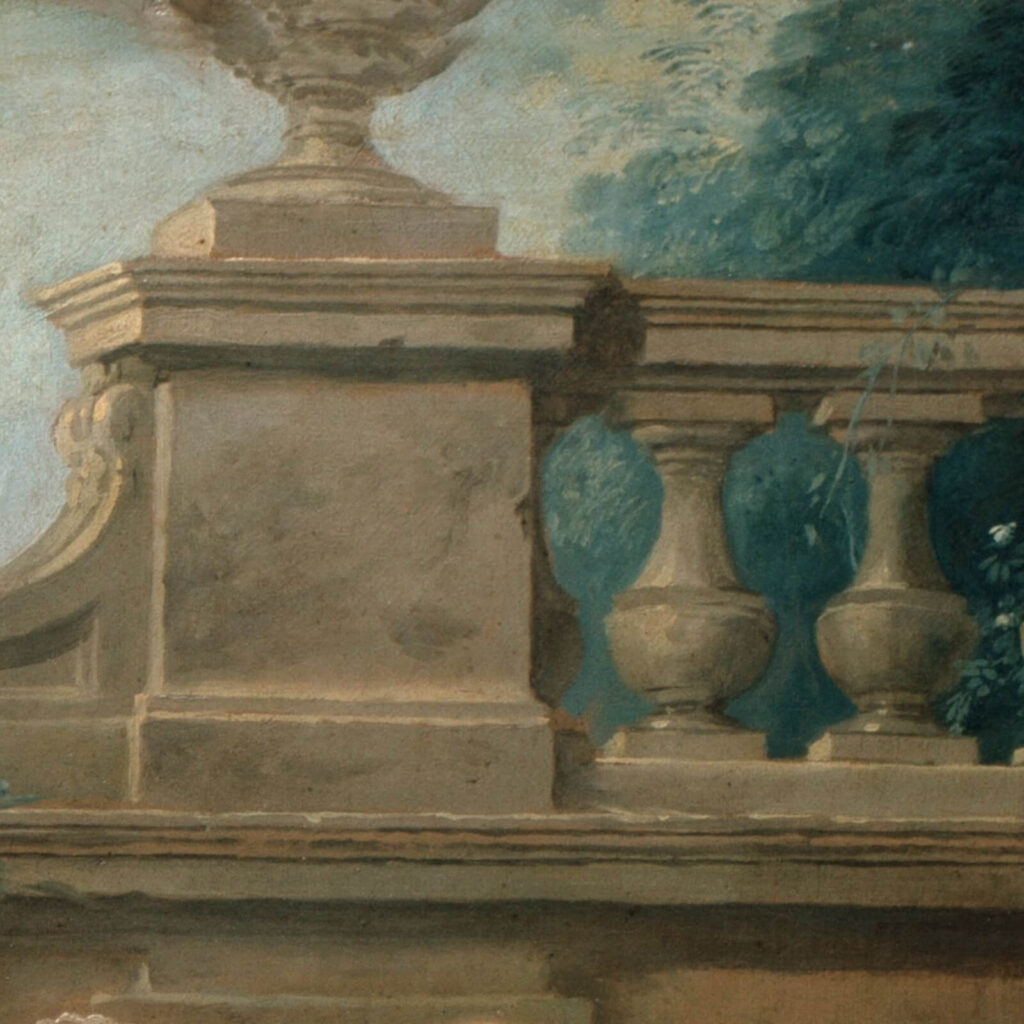
Jean-François de Troy, The Declaration of Love, 1731, Sanssouci, Potsdam, Germany. Detail.
Before the invention of air-conditioning in the early 20th century, hand fans were a vital accessory of ladies aiming to stay cool. Therefore, De Troy’s inclusion of hand fans in the painting suggests that the scene is occurring during a warm summer day.
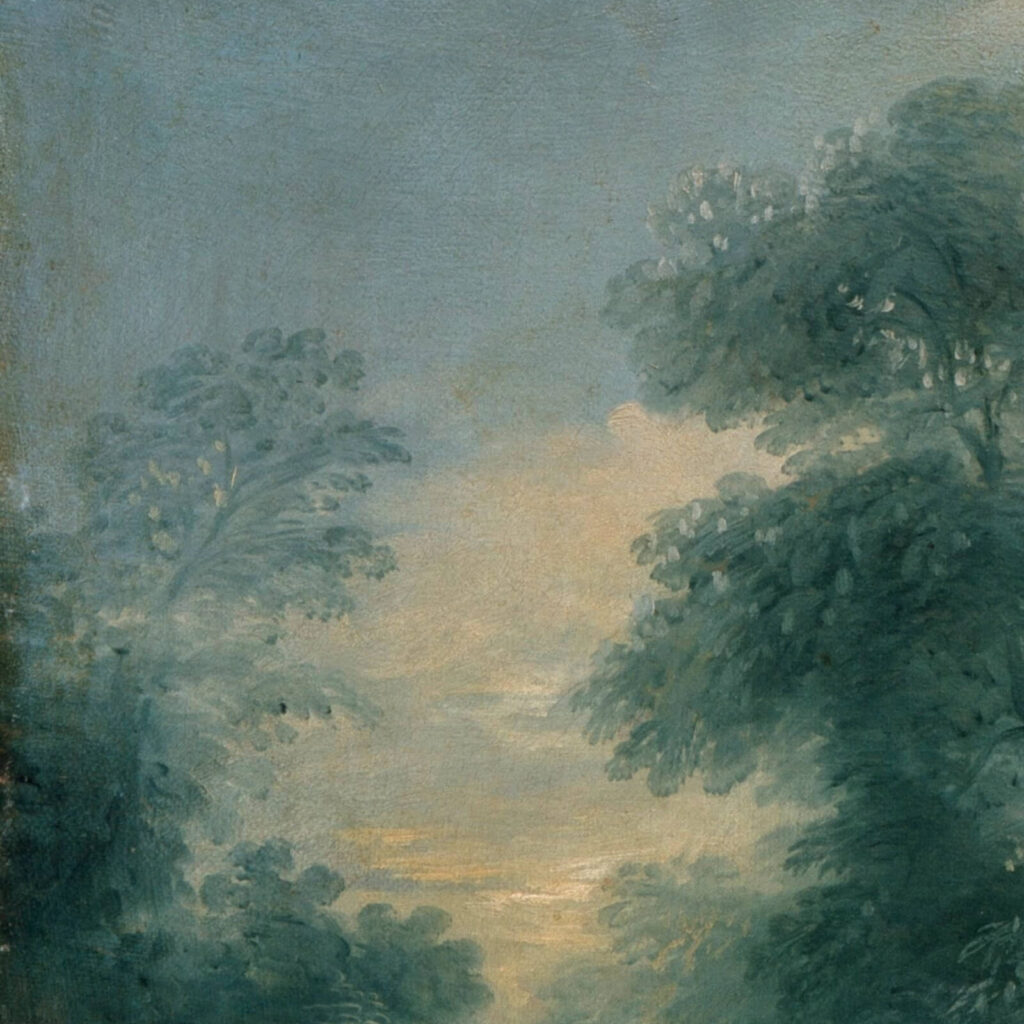
Jean-François de Troy, The Declaration of Love, 1731, Sanssouci, Potsdam, Germany. Detail.
This seasonal suggestion is further implied by the light-colored apparel worn by the ladies and gentlemen in the foreground.

Jean-François de Troy, The Declaration of Love, 1731, Sanssouci, Potsdam, Germany. Detail.
Everyone except for the lady on the far right is wearing summer-appropriate colors that reflect the sunlight and keep the wearer cool.

Jean-François de Troy, The Declaration of Love, 1731, Sanssouci, Potsdam, Germany. Detail.
Additionally, hand fans were an important tool in the courtly entertainment of flirtation and conversation. How a lady held her fan could suggest different messages to the receiving gentleman. One motion could be an invitation to discuss further, while a partially-concealed face might imply modesty or embarrassment. A quick opening of the fan in a jerking motion could be a refusal or annoyance. This language of the fan is sadly lost and forgotten by most of 21st-century society, but throughout the 18th century, it was a subtle form of communication where indiscretion and intrigue held hands.
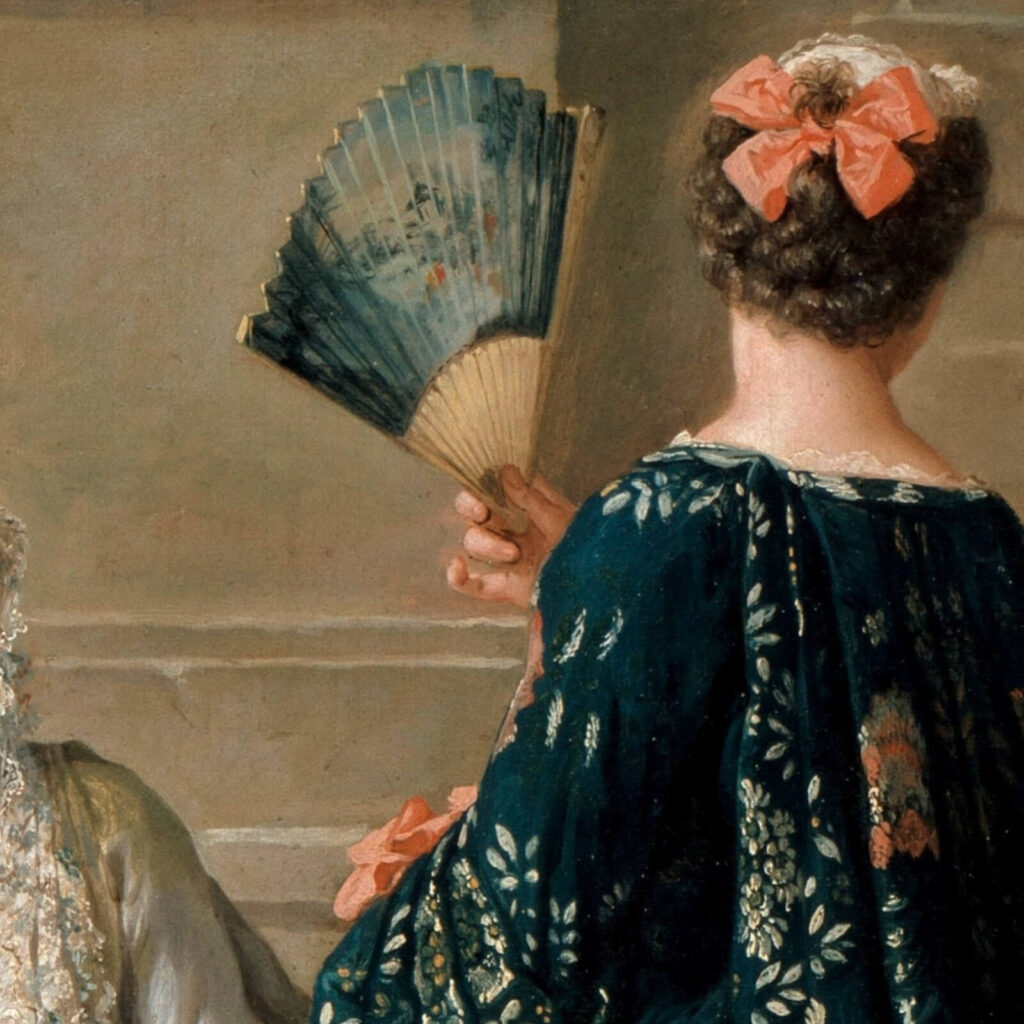
Jean-François de Troy, The Declaration of Love, 1731, Sanssouci, Potsdam, Germany. Detail.
Undoubtedly, the 18th century could be defined as an era obsessed with manners and fashion. How one acted and dressed immediately determined one’s place in society and how one’s life would be experienced. De Troy was no exception to this influence as he deftly captures the subtle and various interactions between the people in the scene. For example, why is the lady in the foreground on the far left seemingly sitting alone? She seems to be interested in the convivial conversation of the other six people in the foreground, but she is not actively engaged. She is physically nearby but not conversationally nearby.
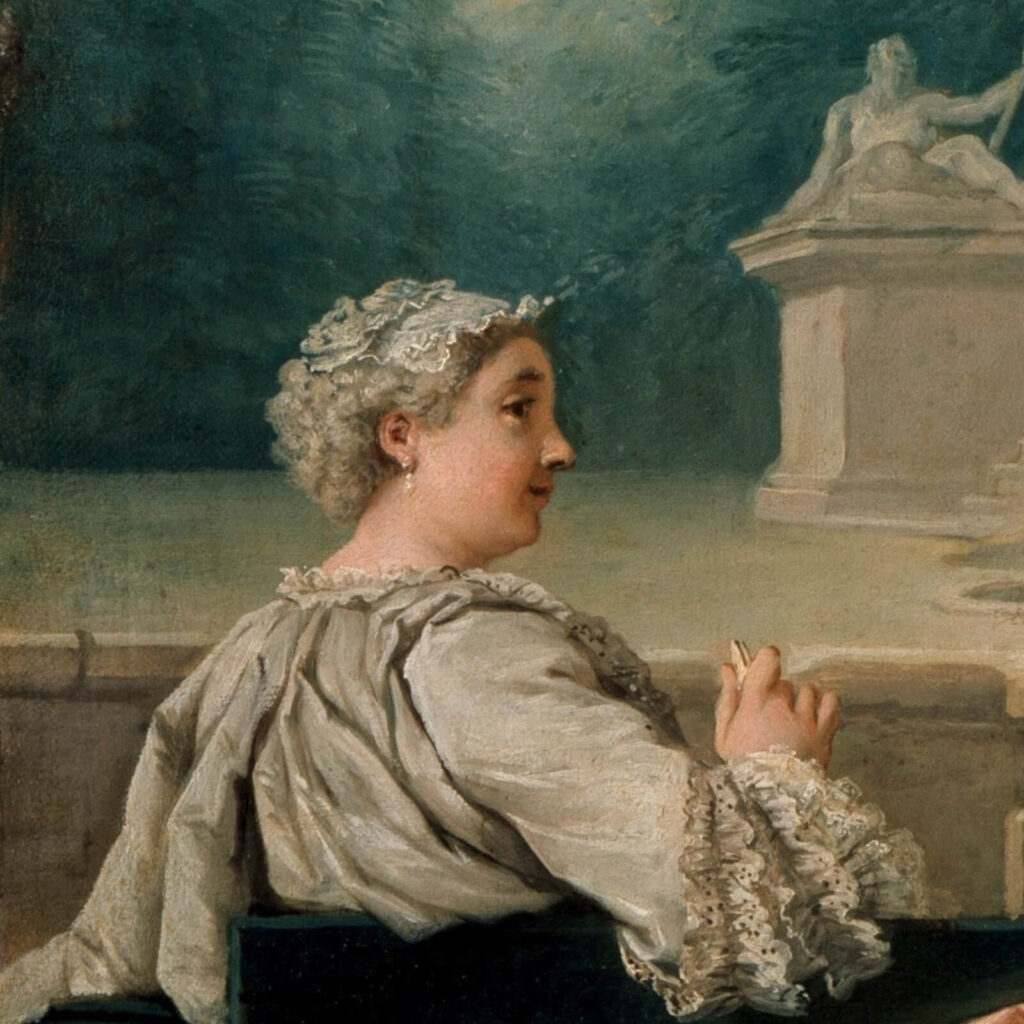
Jean-François de Troy, The Declaration of Love, 1731, Sanssouci, Potsdam, Germany. Detail.
Is she perhaps a chaperone to the other three ladies? Her appearance implies it. Her lace headpiece does not have flowers or ribbons, unlike the other ladies, and therefore seems more sobering but dignified in confident maturity. Her face also reflects a feminine maturity with its roundness and implication of a slight double chin. It could be easily proposed that this woman is the mother, aunt, or older sister to one of the younger ladies in the scene.
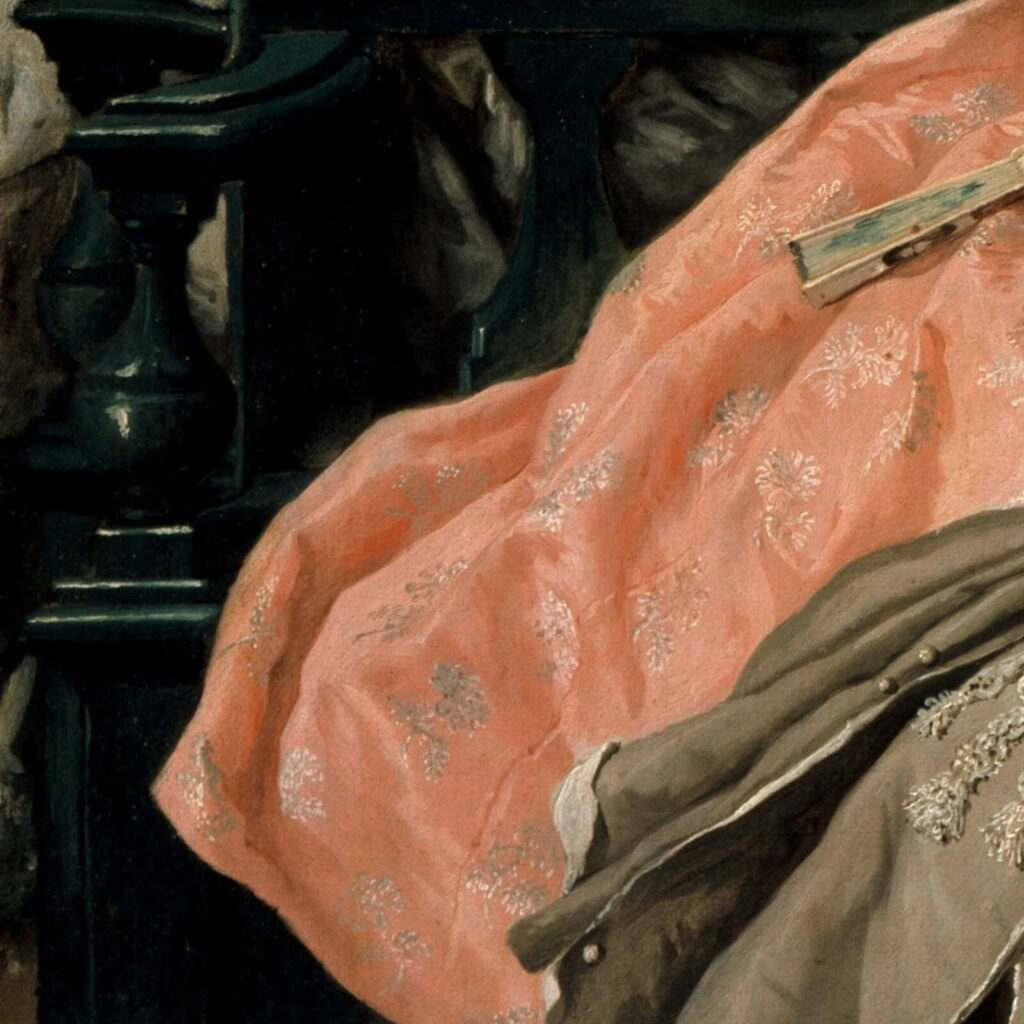
Jean-François de Troy, The Declaration of Love, 1731, Sanssouci, Potsdam, Germany. Detail.
In the center of the painting are the two main figures that give the title to this painting, The Declaration of Love. A beautifully dressed woman, in a champagne colored dress with white and gold embroidery, sits on a park bench. Her face is tilted down-left as she faces a man on bent-knee who wears a gray-olive ensemble.
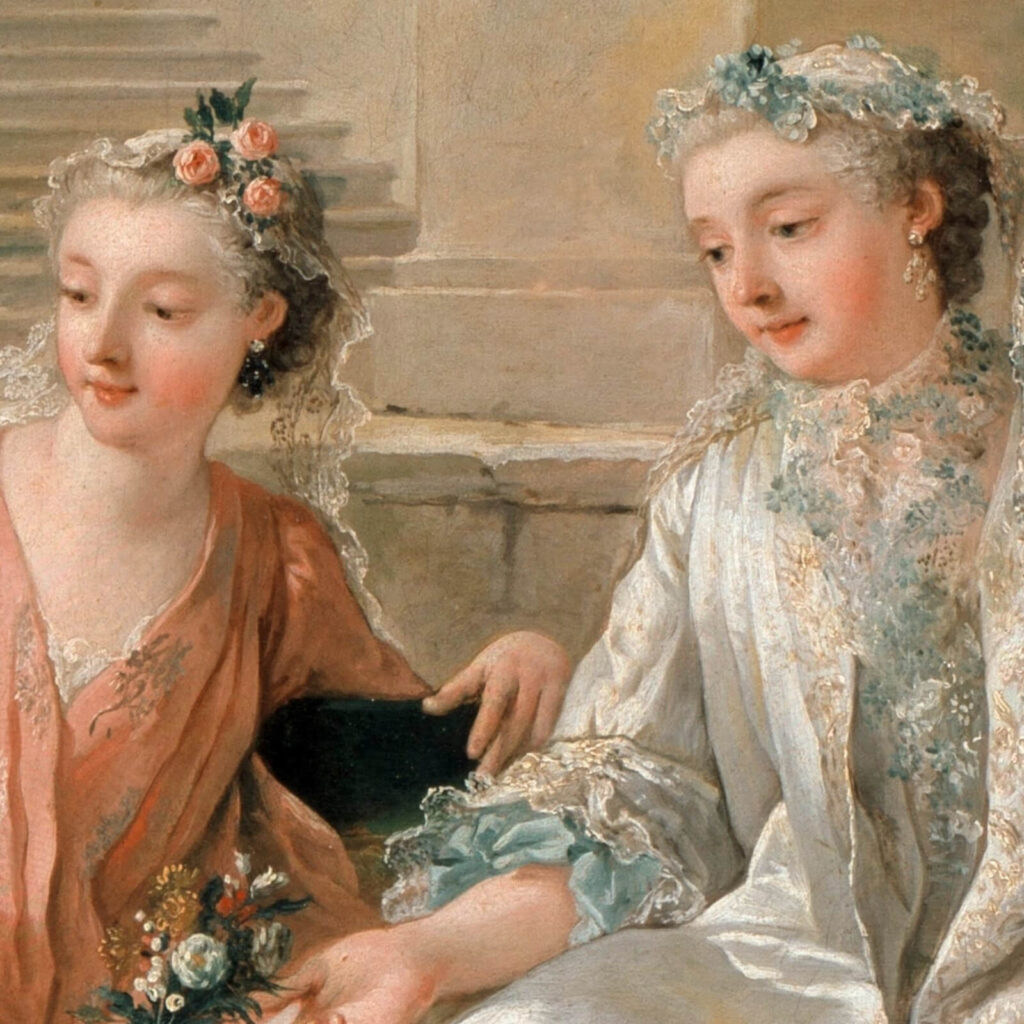
Jean-François de Troy, The Declaration of Love, 1731, Sanssouci, Potsdam, Germany. Detail.
The young man hands the young woman a small bouquet of flowers while he presses his other hand to his heart. The viewer can almost imagine his sweet words as he confesses his love and admiration to her.
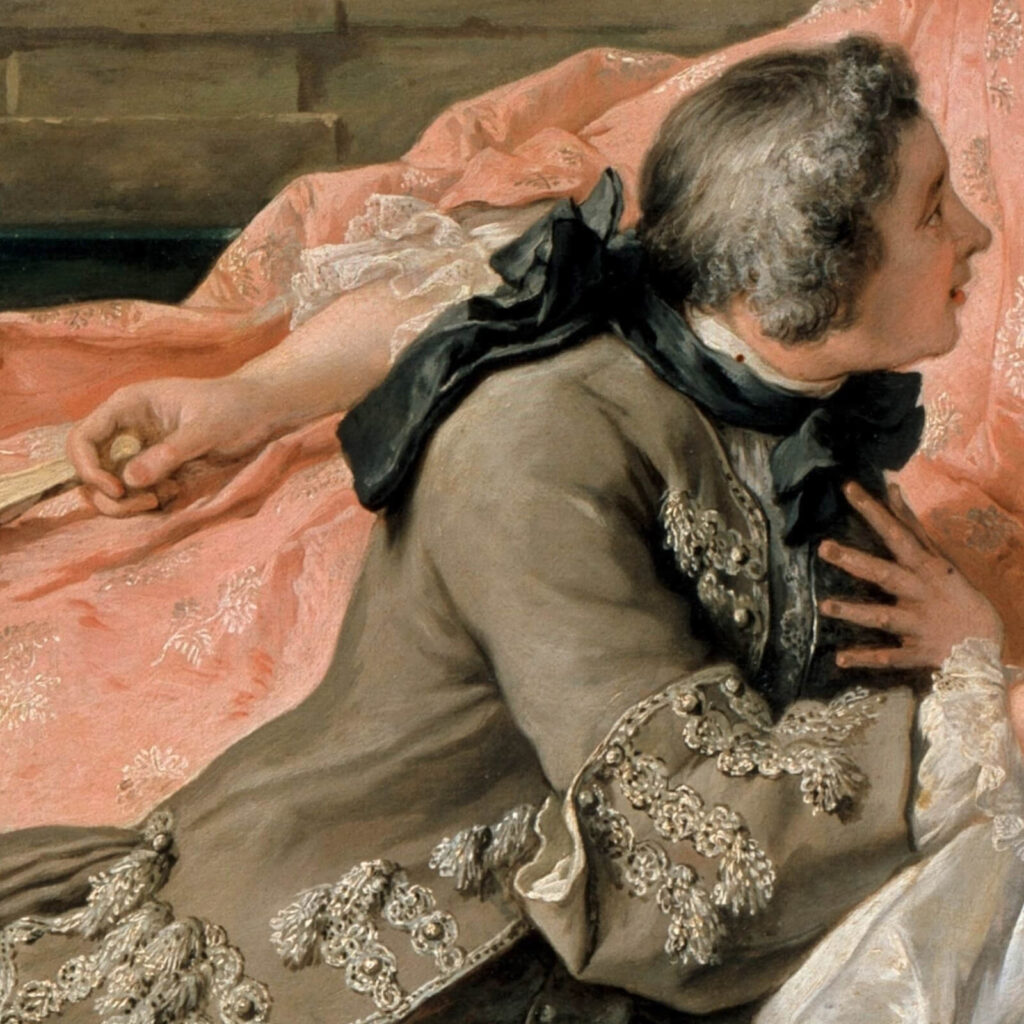
Jean-François de Troy, The Declaration of Love, 1731, Sanssouci, Potsdam, Germany. Detail.
The woman receiving the flowers does not betray her inner feelings. Her face remains calm but reflective. Perhaps De Troy is capturing the moment just before she replies? Will she reciprocate his feelings? Will she reject him with polite grace? Or perhaps she will hold the moment and not say anything? The Declaration of Love captures a universal moment: half agony and half hope.
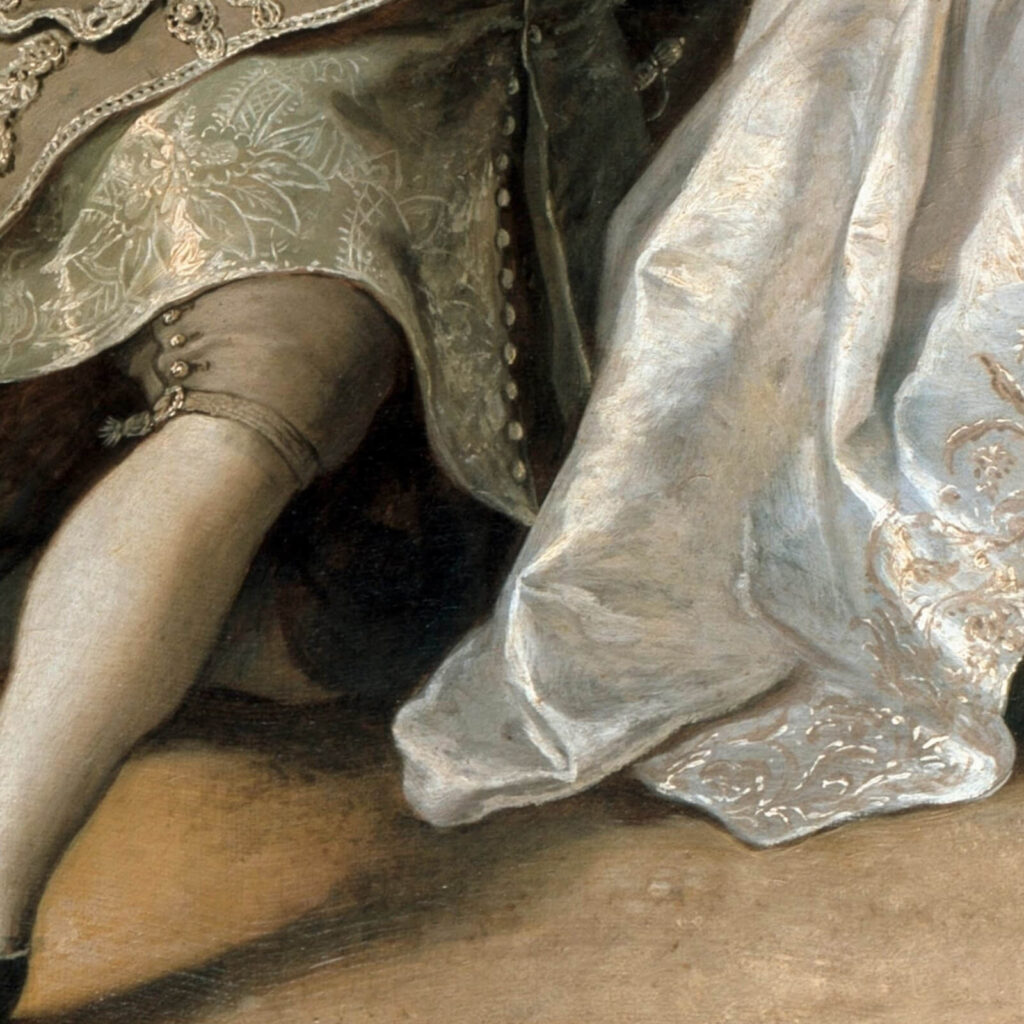
Jean-François de Troy, The Declaration of Love, 1731, Sanssouci, Potsdam, Germany. Detail.
Die Liebeserklärung, Prussian Palaces and Gardens Foundation Berlin-Brandenburg Online Collection. Retrieved Jul 23, 2025.
Michael Levey, Painting & Sculpture in France 1700–1789, New Haven, Yale University Press, 1993.
DailyArt Magazine needs your support. Every contribution, however big or small, is very valuable for our future. Thanks to it, we will be able to sustain and grow the Magazine. Thank you for your help!